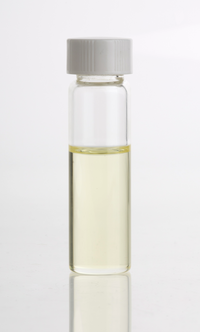Sandalwood oil is an essential oil obtained from the steam distillation of chips and billets cut from the heartwood of various species of sandalwood trees (eg. Santalum album and S. spicatum).
Sandalwood oil is used in perfumes, cosmetics, and sacred unguents.

A glass vial containing pure Sandalwood Essential Oil.
Main constituents
Sandalwood oil contains more than 90% sesquiterpenic alcohols of which 50-60% is the tricyclics α-santalol. β-Santalol comprises 20-25%.
The composition of the oil will depend on the species, region grown, age of tree, and possibly the season of harvest and details of the extraction process used.
Current ISO standards for S. album oil, are 41-55 % α-santalol and 16-24 % β–santalol (ISO 3518: 2002E).
Traditional uses
Sandalwood essential oil is used in Ayurvedic medicine for the treatment of both somatic and mental disorders. A study investigating the effects of inhalation of East Indian sandalwood oil and its main compound, α-santalol, on human physiological parameters found that the compounds elevated pulse rate, skin conductance, and systolic blood pressure.
Sandalwood oil and α-santalol have been associated with chemopreventive activity in animal models of carcinogenesis.
ProductionThe oil is distilled from the wood of the entire tree including stump and roots. (See also Sandalwood#Production).
Synthetic equivalents
There are several synthetic odorants with odour similar to sandalwood oil, used as lower-cost alternatives for perfumes, emollients, and skin cleaning agents. Two of these, Sandalore and Brahmanol, have been found to be agonists of the cutaneous olfactory receptor OR2AT4, with potential therapeutic benefits for wound healing. Natural sandalwood oil, and other synthetic sandalwood odorants, did not have the same effect.
References
- ^ a b Kapoor LD (2001). Handbook of Ayurvedic Medicinal Plants. Herbal Reference Library Series 2. Boca Raton, FL: CRC Press. ISBN 9780849329296.
- ^ a b c Sandalwood Essential Oil, http://scienceofacne.com/sandalwood-essential-oil/Has references.
- ^ Krotz A, Helmchen G (1994). "Total Syntheses, Optical Rotations and Fragrance Properties of Sandalwood Constituents: (−)-(Z)- and (−)-(E)-β-Santalol and Their Enantiomers, ent-β-Santalene". Liebigs Ann Chem 1994 (6): 601–609. doi:10.1002/jlac.199419940610.
- ^ Preliminary oil results from a 14-year-old Indian Sandalwood (Santalum album) plantation at Kununurra, WA
- ^ a b Heuberger, E; Hongratanaworakit, T; Buchbauer, G (2006). "East Indian Sandalwood and alpha-santalol odor increase physiological and self-rated arousal in humans". Planta Medica 72 (9): 792–800. doi:10.1055/s-2006-941544. PMID 16783696.
- ^ Dwivedi C, Ahang Y (1999). "Sandalwood oil prevents skin tumour development in CD1 mice". Eur J Cancer Prev 8 (5): 449–455. doi:10.1097/00008469-199910000-00011. PMID 105484011
- ^ Dwivedi C, Guan X, Harmsen WL, Voss AL, Goetz-Parten DE, Koopman EM, et al. (2003). "Chemopreventive effects of alpha-santalol on skin tumor development in CD-1 and SENCAR mice". Cancer Epidemiol Biomarkers Prev 12 (2): 151–156. PMID 12582025
- ^ Benencia F, Courreges MC (1999). "Antiviral activity of sandalwood oil against Herpes simplex viruses-1 and -2". Phytomedicine 6 (2): 119–123. doi:10.1016/S0944-7113(99)80046-4.
- ^ A Synthetic Sandalwood Odorant Induces Wound-Healing Processes in Human Keratinocytes via the Olfactory Receptor OR2AT4, Daniela Busse1, Philipp Kudella1, Nana-Maria Grüning, Günter Gisselmann1, Sonja Ständer, Thomas Luger, Frank Jacobsen, Lars Steinsträßer, Ralf Paus, Paraskevi Gkogkolou, Markus Böhm, Hanns Hatt and Heike Benecke, Journal of Investigative Dermatology (2014) 134, 2823–2832; doi:10.1038/jid.2014.273; published online 7 August 2014
- ^ New Scientist magazine,Skin’s ability to ‘smell’ seems to help it heal itself, 8 July 2014
Wikipedia





No comments:
Post a Comment